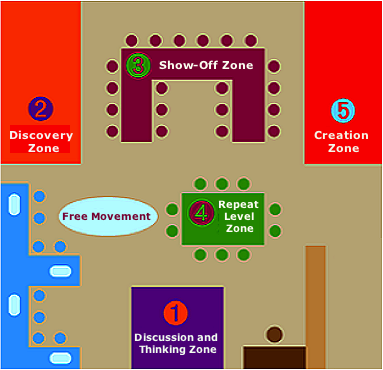How can the wonder of playing with toys translate into the joy of playing with ideas? Curiosity and inquisitiveness form the beginnings of meaningful learning about ourselves and the world. A study in the journal Neuron discovered that students are more interested in learning about topics if their curiosity has been piqued. Matthias Gruber hypothesized that curiosity “put[s] the brain in a state that allows it to learn and retain any kind of information, like a vortex, that sucks in what you are motivated to learn, and also everything around it.” Teachers need to act upon students’ curiosities beyond kindergarten, to learn to wonder, to speculate to ask questions. A rich body of research shows that preschool children use questions to learn at home, but this pattern changes when they enter school. So, what better way to make sure our classrooms provide the supportive environments our students need to get the greatest benefits from their early tendency to ask questions than to create Curiosity and Creativity Zones?
Here are some Tips to consider when setting up zones:
- Make your Curiosity Zones different from your Learning Centers. A “Discovery Zone” is student centered and encourages creative freedom. A Learning Center is teacher created and provides avenues for practice on a skill already taught. A Curiosity Zone should be a safe space that encourages risk taking. At a “Discovery Zone” students could find items to manipulate, photos to consider, poems to ponder, technology to explore, or nature to observe.
- Promote Creativity Skills in a Creation Zone. This zone creates a space where ideas can grow by encouraging novel thinking and problem solving. Students feel empowered when they have choices. “Creation Zones” promote creativity skills when students brainstorm many (fluency), different (flexibility), and unusual (originality) ideas; add to an idea (elaborate) or combine an idea with another idea (flexibility). (Drapeau, 2014). This zone doesn’t concentrate on gaining information, but rather focuses on “thinking”. This zone might be populated with student questions. Alfie Kohn says, “Deep questioning help kids stay curious, grow increasingly resourceful at figuring things out, and become active meaning makers. In traditional classrooms, students are rarely asked what they’ve been wondering about. Innovators ask questions.
The question, “What if we put wheels on it?” led to the rolling suitcase. The question, “What if Morse Code could be adapted graphically?” led to the creation of the bar code. The question, “Why did my candy bar melt? Led to the invention of the microwave oven.
- Make a “Wonder Zone” to Guide Instruction. Using the K-W-L (What do you Know, What do you Want to Know, What did you Learn) strategy can be a powerful tool to put at this zone, but make the W stand for “Wonder about”. Students need time to “wonder” about a topic. So, often the K-W-L strategy is done on the spot at the beginning of a unit in a whole group. Putting it in a “Wonder Zone” or at a “Wonder Window” gives students time to come up with questions that can help teachers frame the direction of future lessons. “Every minute students are forced to spend memorizing the definition of a word (What does nationalism mean?) is a minute not spent wrestling with ideas. (What would the world be like if there were no countries?)”. (Kohn, 2015)
- Keep the Zones in the Same Place all Year. To build community, make these “Zones” permanent spaces in your room. Change the prompt or artifacts to explore based on your next unit of study, student interests or just something interesting you learned about while being curious yourself. There is evidence that an adult’s expression of curiosity can be contagious. (Engel, 2011) Make student interests a priority in your classroom, by making sure there is a constant reminder that their questions matter.
- A final suggestion, set opportunities for students to visit these zones at important times. They should not be used to fill time before the end of class or as a reward for good behavior. They should be intentionally orchestrated to make your classroom environment meaningful and purposeful. Designing these Curiosity and Creativity Zones, which provide space and time to explore, will not only help you know your learners well, but also help you learn from them.
Resources
7 Learning Zones Every Classroom Must Have
Embracing Student Creativity with a Wonder Shelf


Comments 2
What if we called the “Show-off Zone” something different? Showing off can have negative connotations. What if instead we called it the talent zone?
Hi Angie,
I think that is a very good observation. I agree with your analysis and really like the relabeling of that area “Talent Zone”.